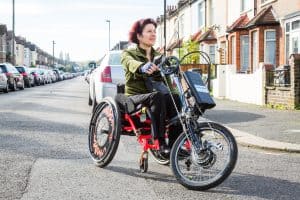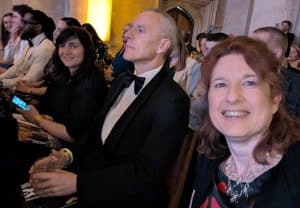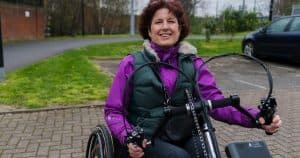We love cycles and we love people’s cycle stories. Our Staff and Trustees share our passion, and we wanted to share it with you too! Our Cycle Stories is a new blog series devoted to introducing you to our wonderful team, and the diverse and varied ways that cycling has become an enriching part of their lives.

What is your name, and what do you do at Wheels for Wellbeing?
My name is Isabelle Clement, and I have been the Director of Wheels for Wellbeing since 2011.
I look after the strategy and finances of the organisation, and work closely with our board and trustees to ensure we stay on track. I’m also responsible for managing the relationships with a lot of our external stakeholders, whether funders or people who want to support us or people we think need to know about us. I’m the ‘public face’ of the organization externally, and the senior manager internally!
What has been your career trajectory? So how did you come to end up working at Wheels?
I started off working in Social Care, managing and recruiting volunteers who were supporting Disabled people to live independently in their own homes. I eventually became the senior manager of that organization, which was based in Lambeth in South London. I moved around to different organisations and roles but until joining Wheels for Wellbeing, in one way or another, I had always focused on Disabled people having control over their own social care, supporting people to live independently.
During this time I also became a Trustee of a local disability organization called DASL which was (and still is) the local Disabled people’s organization in London. The Welfare Services Manager there, Janet Paske, started going on this journey of wanting to create a disability and cycling organization locally, and was at the point where she needed Trustees, I was one of the people she asked to be on the board of the new charity she was setting up and which would become “Wheels for Wellbeing”.
Being on the very first original board, I thought hers was quite a strange idea. I didn’t really think about cycling and disability at that time, but I felt I could help with my experience of charity boards, and I was happy to do that. So that’s how I came across the organisation. It wasn’t even born yet. I knew nothing about cycling but I stayed on the board for a good number of years.
Janet grew the organisation very successfully but eventually she moved out of London and we, the Board, recruited somebody to replace her. When that person started to consider moving on a year later, I was still working in Social Care, for a local authority. I could see it was the best job in the world and, to be honest, I’d found out by then that working in a local authority really wasn’t my bag. So, I resigned from my role as a Trustee of Wheels for Wellbeing, applied for the job and got it. Wonderful!

Do you use a cycle? What? What sort of cycle do you use?
I use a clip-on handcycle, which is a device which turns my wheelchair into a handcycle and is electric-assist. We call it a hybrid handcycle, as it’s muscle-powered with electric support. I started using it fully when I started working at Wheels for Wellbeing, and it’s completely changed my mobility. Actually, I was going to say, it’s changed my life. That sounds a bit grand, but really, it means that I can not only live what I preach in terms of the job that I do, but it’s also a means of mobility: sustainable mobility, active mobility, and it’s keeping me in good health. It’s the only exercise I do which either isn’t boring, like physiotherapy would be, or doesn’t injure me. And it doesn’t involve lots of preparation or going somewhere special to do it, like swimming does. I love swimming, but it’s just too much of a faff, so I rarely do it. In short, cycling improves my health and my mental health, as well as providing me with mobility and transport.
What does cycling mean to you? Your overall wellbeing?
It provides me with endorphins. I’d never experienced the benefits, the mental wellbeing benefits, of endorphins until I got my first clip-on handcycle in my mid-30s, because I couldn’t exercise. I couldn’t make my body make enough of an effort safely and sustainably to get the rush of the endorphins. I could drive around in my car, but it didn’t make me feel happy! It got me places. Whereas cycling gets me places AND makes me feel good. So, cycling is absolutely crucial to my life now and I guess it has become part of my identity as well, because I am the Director of a cycling organisation and I’m one of the few people who cycle around London with a clip-on handcycle.
As well as the endorphins, cycling is great for my self-image as a now-ageing Disabled woman! Handcyclists are still quite rare in towns and cities, so quite noticeable, and I like the way people respond to me when I ride by. I’m not anonymous, like I am in the bubble of my car. People actually notice me as a Disabled person, and they look positively at me in a way that they don’t when I’m just pushing my wheelchair along the pavement. Cycling provides me with hundreds of micro-encounters along my rides and that’s lovely. Even in a relatively anonymous place like London, people look up and make eye contact and, most of the time, I see them smile at what they’re seeing (a woman riding a cool looking machine). Kids say “oh, mum, I want one of those!”; teenagers tell each other “wow, that’s sick, man!” etc. No one’s ever said that about my wheelchair when it’s not been attached to my clip-on. That’s what cycling can do: challenge and re-engineer people’s pre-conceptions of what being Disabled means. That’s powerful!

Do you have a favourite session or adventure or route that you like to do?
My favourite cycle ride is to go to Maltby Street Market in Bermondsey, because it’s got the most amazing vegan cake store there. So, it’s led by my stomach, but it’s also a lovely ride. And it’s only 20 minutes cycling from me, now as I’ve moved closer. Otherwise, any ride on a sunny day just makes me feel happy. Beyond that, I’m always very happy to be at any of our Wheels for Wellbeing sessions, because they’re just amazing.
I don’t have a favourite ride other than those. I’m not really an off-road rider. I love being in the countryside, but it’s not nearby to me, and I love riding in London. A lot of people think you’re mad to want to cycle in London, but there are plenty of really beautiful places to get to and to go through. I rode from South London to the Olympic Park recently for an event, and a lot of that was along the canal. Now, I wouldn’t necessarily recommend cycling ‘along the canal’, but on that particular day, it was beautiful. It’s not super safe because it’s too narrow, but it’s so lovely to be by the water! I wouldn’t be able to get to it without my handcycle. So yeah, being in nature, but also just getting somewhere. If I’m not getting somewhere, I don’t… I’m not motivated enough to cycle just for its own sake!
Is there anything that you think Wheels for Wellbeing does better than anyone else?
We are thought leaders in the field of Disability, active mobility and cycling.
Some people know us for offering practical inclusive cycling sessions in South London; others for being the national advocacy voice of Disabled people who cycle and for providing expert training and consultancy on that topic. We do both. We are the only Disabled people’s organisation representing Disabled cyclists, their views and their needs and I’m very proud of that. We’re also the only cycling organisation led by Disabled cyclists, as far as I know, and that’s what shapes our own work and expert technical knowledge. It’s a lot to be proud of.
If you had a magic wand, what one thing would you choose to change in #ActiveTravel or #InclusiveCycling to benefit disabled people?
It’s always a difficult one, isn’t it, if I had a magic wand…?
I would get everybody who works in Active Travel to understand that when we meet the needs of Disabled people who cycle, we make it possible to get the whole population cycling. I don’t think I’ve quite convinced the world of that fact yet but I’m still working on it. Because meeting the needs of Disabled people who want to cycle means removing the vast majority of barriers to cycling for the rest of the currently non-cycling population. They’re the same barriers which stop the vast majority of the British population from cycling: the cost of a good e-cycle, lack of safety on the roads, the need to have a variety of different types of cycles available and infrastructure on which to be able to use them, plus safe and accessible places to store all kinds of cycles, etc.
We also need to quash the ridiculous narrative about cyclists being a group of people worthy of hatred, for some reason… this too stops the vast majority of people cycling (children, older people and everyone in between).
Ensuring that all kinds of people can cycle all kinds of cycles will make cycling possible and enjoyable for everyone and it’ll benefit the individuals, whilst saving millions to the NHS. What’s not to like? In fact, this shouldn’t need a magic wand and I hope this country wakes up to this reality very soon!
Thank you for sharing your Cycle Story with us, Isabelle!
